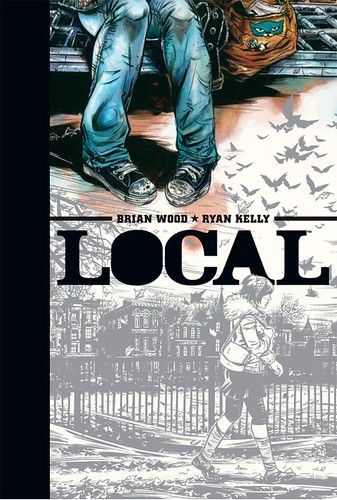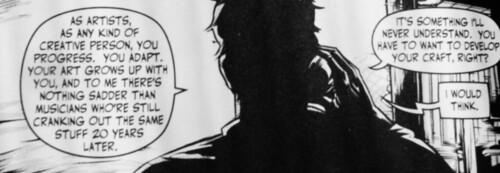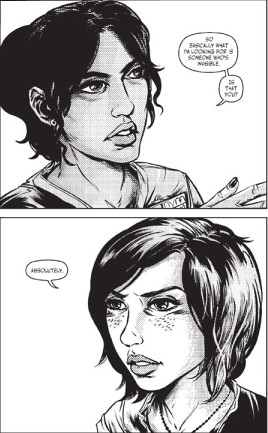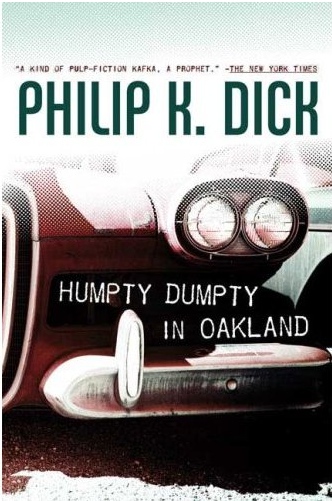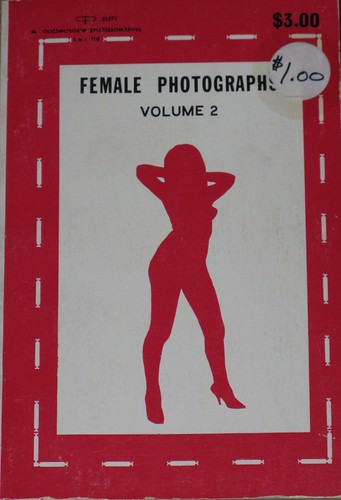Easily one of the best things I've read in any format over the last few weeks is the comic book series collection Local, written by Brian Wood (DMZ, Demo, Northlanders) and illustrated by Ryan Kelly (Lucifer, Northlanders).
The series began as an experiment for Wood and Kelly; they wanted to write a limited series with each issue set in a different city in North America. They avoid the major cities like New York and L.A., focusing on mid-sized cities that offer lots of color and personality. To help with the local flavor they partnered up with artists in each city to get sketches and/or photos of key places---Bryan Lee O'Malley, for example, contributed a bit to the look of the chapter set in Halifax, Nova Scotia.
Megan McKeenan---a punky twenty-something woman with wanderlust----works as the thread tying the twelve issues together. Each year she moves to a different city, and we watch her life as she finds a job, makes friends, searches for love, and tries to find herself. In the beginning Megan is primarily a device. She's the focus of the opening story, but for several in a row she functions as a secondary character.
I was intrigued by Local but not really wowed until chapter 3, a story called "Theories and Defenses". The chapter looks at a successful rock band that started in Richmond and what happens to them after their own success drives them apart. The band members return to their hometown and we see how each band member deals with their new state in life. This chapter not only displays lots of local landmarks that I know---southern row houses, the Fan, Plan 9 Records---but it really nails all the personalities you get with a band. There's the cocky lead singer who wants to do a solo album, the bass player who just wants to go out and get laid every night and the guitarist who seems perfectly happy tackling the coffee shop scene with his acoustic guitar.
But by chapter five Wood and Ryan return to Megan full force and the story becomes solely about her. She works at a historic movie theatre in Halifax, changing her name every day to confuse the patrons. In Minneapolis she develops a relationship with an odd guy who breaks into her apartment every day and leaves her a polaroid photo of himself. Later Megan has her life stolen and put on display by an art student in Toronto. As someone who switched jobs several times and spent way too many hours in my early twenties soul-searching, Megan's awkwardness, confusion and even anger come across to me as very real.
Kelly's artwork is a great match for Wood's story; the black and white indie look equates with the vagabond spirit of the story. If you are familiar with the city in a particular chapter, you will definitely see landmarks that look and feel like the real places. I also really like how he does faces; each face, be it a main character like Megan or someone who just walks by, has their own unique personality and they come across very well.
As the series develops we slowly learn the reasons why Megan moves every year, what she's searching for and what she's running from. For something that started as a quirky experiment in comics, by the end it develops into one of the more emotionally effective stories put out over the last year.
Excelsior
Thursday, January 29, 2009
Friday, January 23, 2009
New Directions
I've been thinking a lot about this space over the past month. What I want to do with it, and even if I want to keep it going. I've decided that my sporadic postings are due, at least in part, to a real lack of focus or structure in what I write about. To help combat this I'm going to lay in some more purposeful structure to what I put here.
To start with, I'm going to pick an author and deal with his or her full set of novels and/or story collections, one at at time, in the order they were published. I considered a pretty big number of authors: Gene Wolfe, Jonathan Lethem, Jeanette Winterson, Jane Bowles, William S. Burroughs, David Mitchell, and on and on. I even considered some long-running comic book series like Y the Last Man and Cerebus. In the end I picked Paul Auster; he's a writer I enjoy and respect, but have only read about a third of his published fiction. I own his first two books, and the others are pretty readily available at the library I work at. I also have a feeling there might be an interesting progression throughout his work.
Auster's first book is a set of three novellas; originally published separately they are now sold as his New York Trilogy. The goal right now is to have something written about the first novella on February 1, and follow with the other two novellas over the following two weeks of the month. We'll see how it goes.
I still plan on reviewing newer material and interspersing it with my usual rants, but I'm hoping this will make things more interesting for both me and the readers out there.
Excelsior
To start with, I'm going to pick an author and deal with his or her full set of novels and/or story collections, one at at time, in the order they were published. I considered a pretty big number of authors: Gene Wolfe, Jonathan Lethem, Jeanette Winterson, Jane Bowles, William S. Burroughs, David Mitchell, and on and on. I even considered some long-running comic book series like Y the Last Man and Cerebus. In the end I picked Paul Auster; he's a writer I enjoy and respect, but have only read about a third of his published fiction. I own his first two books, and the others are pretty readily available at the library I work at. I also have a feeling there might be an interesting progression throughout his work.
Auster's first book is a set of three novellas; originally published separately they are now sold as his New York Trilogy. The goal right now is to have something written about the first novella on February 1, and follow with the other two novellas over the following two weeks of the month. We'll see how it goes.
I still plan on reviewing newer material and interspersing it with my usual rants, but I'm hoping this will make things more interesting for both me and the readers out there.
Excelsior
Thursday, January 15, 2009
Review: Humpty Dumpty in Oakland by Philip K. Dick
Best known for his psychedelic, mind-bending sci-fi, Philip K Dick wrote all kinds of stories early in his career. Humpty Dumpty In Oakland is a rare realistic novel of his written in 1960; rejected by his publisher and finally published after his death in 1986 by UK publisher Gollancz, it became available in the US this past fall.
Set in San Francisco during the late 1950's, Humpty gives us the story of used car salesman Al Miller and his elderly landlord, Jim Fergusson. Miller's view on life quickly descends when Fergusson decides to sell his land and open up a car repair shop in the developing suburbs just outside the city, leaving Miller to fend for himself and search for a new way of life. Miller also fears Fergusson will be ripped off by the shady businessmen putting the deal together, so Miller tries to uncover the truth to protect his friend. Instead Miller bumbles into and backs out of a job in the recording industry, causes Fergusson to have a heart attack and makes the final move that ends his marriage with his overbearing wife. Despite the grim plot PKD works in some odd touches of dark humor, particularly when writing about the pop culture of the day.
This is far from a perfect novel, and not anywhere near PKD's best or most interesting. With a story that flip-flops between Miller and Fegusson, it's hard to tell whose story PKD is trying to tell here. Honestly, anyone new to PKD reading this probably won't get the cult following around his books. But people familiar with his Sci-fi will see a lot of familiar ideas. Like with many of his novels, Humpty looks at a society on the cusp of change and tries to show how this change will shape the lives of ordinary, everyday folks. Instead of contact with an alien race or the rise of androids who want to live their own lives, Humpty looks at the more down-to-earth issues of Suburbanization and the growth of Corporate culture. There's probably a paper in this somewhere, looking at PKD's major themes and doing a compare/contrast in how he deals with them in his realistic work vs. his imaginative work. But I'll save that for an industrious English major to tackle.
Excelsior.
Set in San Francisco during the late 1950's, Humpty gives us the story of used car salesman Al Miller and his elderly landlord, Jim Fergusson. Miller's view on life quickly descends when Fergusson decides to sell his land and open up a car repair shop in the developing suburbs just outside the city, leaving Miller to fend for himself and search for a new way of life. Miller also fears Fergusson will be ripped off by the shady businessmen putting the deal together, so Miller tries to uncover the truth to protect his friend. Instead Miller bumbles into and backs out of a job in the recording industry, causes Fergusson to have a heart attack and makes the final move that ends his marriage with his overbearing wife. Despite the grim plot PKD works in some odd touches of dark humor, particularly when writing about the pop culture of the day.
This is far from a perfect novel, and not anywhere near PKD's best or most interesting. With a story that flip-flops between Miller and Fegusson, it's hard to tell whose story PKD is trying to tell here. Honestly, anyone new to PKD reading this probably won't get the cult following around his books. But people familiar with his Sci-fi will see a lot of familiar ideas. Like with many of his novels, Humpty looks at a society on the cusp of change and tries to show how this change will shape the lives of ordinary, everyday folks. Instead of contact with an alien race or the rise of androids who want to live their own lives, Humpty looks at the more down-to-earth issues of Suburbanization and the growth of Corporate culture. There's probably a paper in this somewhere, looking at PKD's major themes and doing a compare/contrast in how he deals with them in his realistic work vs. his imaginative work. But I'll save that for an industrious English major to tackle.
Excelsior.
Tuesday, January 06, 2009
Grandpa's Secret Stash
The last few weeks have been all about moving. Moving boxes, moving furniture, moving little knick-nacks and finding places for all these things in our new apartment. Things are getting more solidified---all the furniture's here, we're starting to put artwork on the walls and are even talking about a house-warming party next month. We still have have a bunch of random things in a storage unit we need to go through---mostly a combination of wedding presents we haven't touched and boxes of books----but we are well on our way to being finished.
Combined with our own move, Miss L and I worked a lot with my dad last week to move my grandpa. We're moving him out of his retirement home into another place where he'll get better care for his dementia and be closer to family. While packing up all his stuff---like me, he mostly has books and music----I stumbled across something I never thought I'd find. Tucked away in the bottom corner of a bookshelf, sandwiched between a book of geological maps of Wisconsin and a biography on HItler, I found his stash of dirty books. Most of them were of the artsy variety---a book of Ingres nudes, a set of Picasso line drawings on pocket-sized cards, and an abbreviated version of the Kama Sutra. But what's sticking in my mind for a variety of reasons are volumes one and two of a series called, quite simply, Female Photographs.
These two little books date back to 1968, and are filled with 80 or so pages of black and white photos of pin-up girls in their undies. Their raciness lies somewhere between Playboy and Penthouse. The back pages are filled with ads for "marital aids" and a strange catalogue of books put out by the same publisher: With Open Mouth, The Talking Jewels, Scientific Curiousities of Sex Life, and on and on. This is old school stuff seems quite quaint and even funny by today's standards.
Now some people may not understand this, but finding grandpa's secret stash makes me feel a little bit closer to him---albeit in an odd manner. In some ways he raised me more than my dad did and I've always put him on a bit of a pedestal. Finding something like this makes grandpa seem more human, more approachable, more real. It makes me feel that despite all my shortcomings maybe I too can live a pretty happy, full life if he managed to.
Back to reviews and other fun things soon.
Excelsior
Combined with our own move, Miss L and I worked a lot with my dad last week to move my grandpa. We're moving him out of his retirement home into another place where he'll get better care for his dementia and be closer to family. While packing up all his stuff---like me, he mostly has books and music----I stumbled across something I never thought I'd find. Tucked away in the bottom corner of a bookshelf, sandwiched between a book of geological maps of Wisconsin and a biography on HItler, I found his stash of dirty books. Most of them were of the artsy variety---a book of Ingres nudes, a set of Picasso line drawings on pocket-sized cards, and an abbreviated version of the Kama Sutra. But what's sticking in my mind for a variety of reasons are volumes one and two of a series called, quite simply, Female Photographs.
These two little books date back to 1968, and are filled with 80 or so pages of black and white photos of pin-up girls in their undies. Their raciness lies somewhere between Playboy and Penthouse. The back pages are filled with ads for "marital aids" and a strange catalogue of books put out by the same publisher: With Open Mouth, The Talking Jewels, Scientific Curiousities of Sex Life, and on and on. This is old school stuff seems quite quaint and even funny by today's standards.
Now some people may not understand this, but finding grandpa's secret stash makes me feel a little bit closer to him---albeit in an odd manner. In some ways he raised me more than my dad did and I've always put him on a bit of a pedestal. Finding something like this makes grandpa seem more human, more approachable, more real. It makes me feel that despite all my shortcomings maybe I too can live a pretty happy, full life if he managed to.
Back to reviews and other fun things soon.
Excelsior
Subscribe to:
Comments (Atom)
